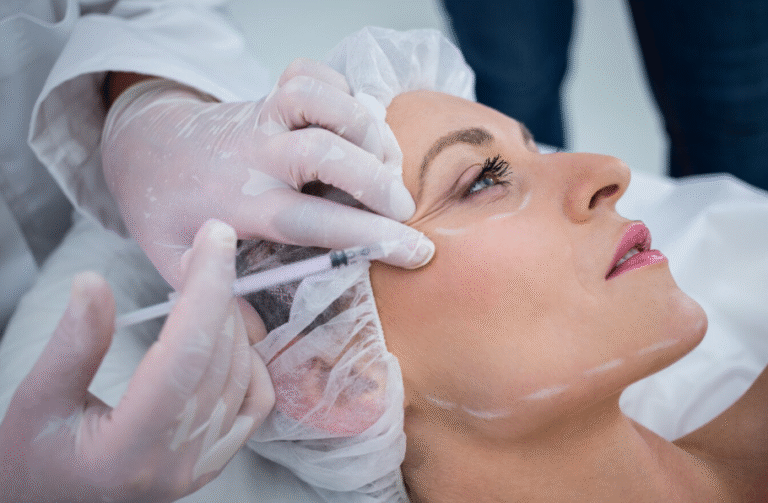Treatment Overview
Ultherapy is a non-invasive treatment that uses High-Intensity Focused Ultrasound (HIFU) to deliver energy deep into the dermis and SMAS (Superficial Musculoaponeurotic System) layer. It stimulates natural collagen and elastin regeneration, making skin firmer and more resilient.
For stretch marks (striae), Ultherapy is used to tighten weakened skin, improve elasticity, and remodel collagen around the affected areas. While not a first-line treatment, in Korea it is often combined with microneedling, lasers, or regenerative injectables to enhance results.
Purpose & Benefits
- Skin Tightening: Firms loose skin around stretch marks.
- Collagen & Elastin Boost: Strengthens dermal tissue for long-term repair.
- Texture Improvement: Helps smooth uneven or thinned-out skin.
- Preventive Effect: Reduces risk of stretch marks worsening.
- Non-Invasive: No downtime, safe for most skin types.
- Synergy: Often used as an adjunct to CO₂ lasers, PRP, or Rejuran therapy.
Ideal Candidates
Ultherapy in Korea for stretch marks is recommended for:
- Adults with mild to moderate stretch marks and skin laxity.
- Patients with thinned, sagging skin around striae.
- Those who want a non-surgical tightening option as part of a combined plan.
Comparison with other treatments:
- Ultherapy (HIFU): Best for deep tightening and elasticity support.
- Fractional CO₂ Laser: Best for resurfacing and scar remodeling.
- Dermapen Microneedling: Best for collagen induction and texture repair.
- PRP/Exosome Therapy: Best for regeneration and healing.
- Skin Boosters/Rejuran: Best for hydration and dermal repair.
Possible Risks & Complications
Ultherapy is very safe, but temporary side effects may include:
- Redness or Warmth: Fades within hours.
- Tenderness or Tingling: May last a few days.
- Swelling: Mild, resolves quickly.
- Rare Risks: Slight nerve sensitivity or uneven tightening (very uncommon).
Surgical Techniques Used
- Ultrasound Imaging: Ensures energy is precisely delivered to target layers.
- Multiple Depth Cartridges: Targets 1.5 mm, 3 mm, and 4.5 mm layers.
- Focus Areas: Abdomen, thighs, hips, breasts, or arms where striae occur.
- Combination Therapy: Often paired with lasers, RF microneedling, or injectables.
- Protocol: Single session; results improve over 2–3 months and last 9–12 months.
Recovery & Aftercare
- Immediately: Redness or slight swelling.
- 1–3 Days: Mild tenderness or tingling.
- 2–3 Months: Progressive collagen remodeling and firming.
Aftercare Tips:
- Apply hydrating serums and creams daily.
- Use SPF 50+ daily on treated areas.
- Avoid heat exposure (sauna, hot baths) for 1–2 days.
- Stay hydrated to support collagen regeneration.
Results & Longevity
- Short-Term (4–6 Weeks): Early tightening and improved texture.
- Medium-Term (2–3 Months): Noticeable firmness and fading of stretch marks.
- Long-Term: Results last 9–12 months; yearly maintenance enhances benefits.
Treatment Process in Korea
- Consultation & Skin Assessment – Doctor evaluates stretch mark depth and skin laxity.
- Preparation – Cleansing and ultrasound gel applied.
- Ultherapy Session – HIFU delivered to dermis and SMAS layer.
- Optional Add-Ons – Fractional CO₂, PRP, or Rejuran injections.
- Post-Care – Cooling mask or antioxidant serums.
- Follow-Up – Maintenance sessions scheduled annually.
Why Korea is a Top Destination
- Korea has world-class expertise in HIFU-based skin tightening.
- Clinics use authentic, KFDA-approved Ultherapy systems.
- Dermatologists specialize in combining Ultherapy with regenerative boosters and lasers for striae.
- More affordable compared to Western clinics.
- Seoul is internationally recognized for multi-step scar and skin rejuvenation protocols.
Cost Range (Detailed Breakdown)
Pricing for Ultherapy in Korea for stretch marks:
- Single Session (localized area): USD 500 – 900
- Larger Area (abdomen or thighs): USD 1,000 – 1,800
- Ultherapy + PRP/Exosome Combo: USD 800 – 1,500 per session
- Premium Stretch Mark Package (Ultherapy + CO₂ Laser + Rejuran/Exosomes): USD 2,500 – 4,500
Additional Costs in Korea:
- Consultation: USD 20 – 40
- Add-ons (PRP, Exosomes, PN, Microneedling): USD 100 – 500
💡 Patients often call Ultherapy the “deep tightening support” for stretch marks, as it firms weakened skin and complements collagen-regenerative treatments.
Popular Clinics in Seoul
- Banobagi Dermatology – Ultherapy + CO₂ laser combos for striae.
- Oracle Dermatology – Ultherapy + exosomes for skin tightening.
- Renewme Skin Clinic – Ultherapy + PRP for repair and rejuvenation.
- View Plastic & Dermatology – Ultherapy with microneedling for scars and striae.
- Chaum Anti-Aging Center – Premium Ultherapy + multi-step repair protocols.




